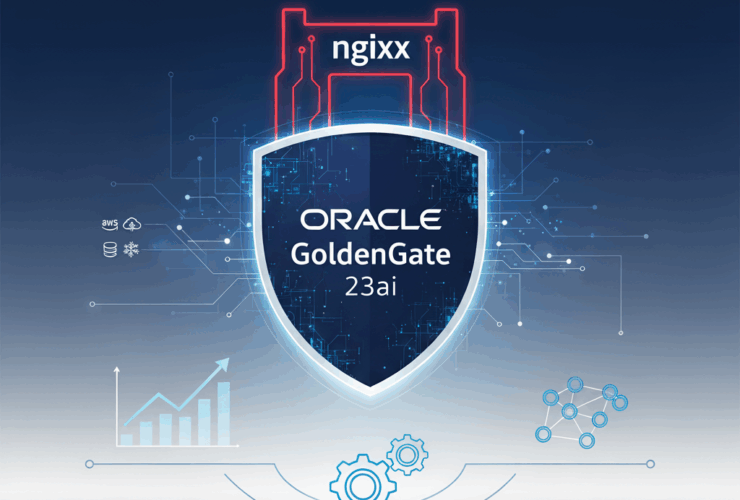Real-Time Oracle Database to Google BigQuery: Powering AI-Driven Analytics with Oracle GoldenGate 23ai

Modern AI and machine learning initiatives demand fresh data to deliver accurate predictions and actionable insights. While traditional batch ETL processes served us well in the past, today’s AI models require continuous data streams to maintain relevance and accuracy.
The retail and supply chain industries exemplify this challenge perfectly. When inventory levels shift, customer behavior changes, or supply disruptions occur, your AI models need immediate access to these changes to provide accurate demand forecasting, fraud detection, and customer recommendations. Oracle GoldenGate 23ai bridges this gap by delivering real-time data replication from Oracle databases to BigQuery, creating the foundation for responsive AI applications.
The Real-Time Replication Architecture
Oracle GoldenGate 23ai operates on a three-tier architecture that captures, distributes, and applies data changes in real-time. Think of it as a sophisticated relay race where each component has a specific role in ensuring your data reaches BigQuery with minimal latency and maximum reliability.
The architecture consists of three core components working in harmony. The Extract process captures transaction log data directly from your Oracle database, the Distribution Service manages the secure movement of that data across networks, and the Replicat process transforms and loads the data into your target BigQuery environment.
Let’s examine a production implementation from our retail client’s supply chain system to understand how this works in practice.
Extract: Capturing Live Transaction Data
The Extract process, which we’ve configured as EXTTSCSF, monitors the Oracle transaction logs on FREEPDB1.CTMS_PSO.TEST_1 in real-time. This isn’t a polling mechanism that checks for changes every few minutes. Instead, it’s a continuous capture process that reads directly from the Oracle redo logs as transactions occur.
Here’s the complete parameter file configuration that drives this process:
EXTRACT EXTTSCSF
USERIDALIAS SOURCE_TSC DOMAIN OracleGoldenGate
EXTTRAIL WW
REPORTCOUNT EVERY 2 MINUTES, RATE
WARNLONGTRANS 30MIN CHECKINTERVAL 10MIN
TRANLOGOPTIONS INTEGRATEDPARAMS (MAX_SGA_SIZE 512, PARALLELISM 2)
NOCOMPRESSUPDATES
TABLE FREEPDB1.CTMS_PSO.TEST_1;
Each parameter serves a specific purpose in optimizing real-time data capture. The USERIDALIAS SOURCE_TSC DOMAIN OracleGoldenGate establishes secure database connectivity using credential aliasing, while EXTTRAIL WW defines the trail file identifier that downstream processes will consume.
The TRANLOGOPTIONS INTEGRATEDPARAMS setting with MAX_SGA_SIZE 512 and PARALLELISM 2 ensures optimal memory utilization and parallel processing capabilities. The REPORTCOUNT EVERY 2 MINUTES provides operational visibility into throughput metrics, while WARNLONGTRANS 30MIN helps identify potential performance bottlenecks before they impact replication.
The NOCOMPRESSUPDATES parameter is crucial for BigQuery integration because it ensures complete before-and-after images of changed rows are captured, enabling proper handling of update operations in BigQuery’s append-optimized storage model.
This Extract process creates a trail file (WW) that contains all the captured transaction data in a compressed, optimized format ready for distribution to downstream systems.
Distribution: Secure Network Data Movement
The Distribution Service (ATL-ATLSF1) handles the network transmission of trail data from our source Oracle environment to the BigQuery replication target. This isn’t simple file copying – it’s a sophisticated streaming protocol that maintains data integrity while optimizing for network efficiency.
The distribution configuration establishes secure connectivity between environments:
Source URI: trail://###.###.###.###:16002/services/v2/sources?trail=WW
Target URI: ws://###.###.###.###:17003/services/v2/targets?trail=WW
The trail:// protocol connects to the Extract trail output, while the ws:// (WebSocket) protocol establishes the streaming connection for real-time data transmission. This WebSocket approach eliminates the polling overhead associated with traditional file-based replication methods.
Distribution processes in GoldenGate 23ai operate as microservices that automatically handle connection management, data buffering, and network optimization. The service monitors network conditions and adapts compression and transmission rates to maintain optimal throughput while preserving data ordering and integrity.
The streaming capability ensures that as soon as the Extract process writes new transaction data to the trail, the Distribution Service immediately begins transmitting that data to the target environment. This eliminates the batch processing delays that plague traditional ETL approaches and enables sub-second data availability in BigQuery for immediate AI model consumption.
Replicat: BigQuery Integration and Transformation
The Replicat process (REPBQ) is where the magic happens for BigQuery integration. This component doesn’t just dump data into BigQuery – it intelligently handles the transformation, formatting, and loading optimized for BigQuery’s columnar storage architecture.
The Replicat parameter file configuration defines the core replication behavior:
REPLICAT REPBQ
REPERROR(DEFAULT, ABEND)
REPORTCOUNT EVERY 1 MINUTES, RATE
GROUPTRANSOPS 10000
MAXTRANSOPS 20000
SOURCECATALOG FREEPDB1;
MAPEXCLUDE GGATE.HEARTBEAT;
MAPEXCLUDE CTMS_PSO.SLASH_TESTING;
MAP CTMS_PSO.TEST_1, TARGET CTMS_PSO.TEST_1;
The REPERROR(DEFAULT, ABEND) setting ensures that any data quality issues cause immediate process termination rather than allowing corrupted data to propagate to BigQuery. This fail-fast approach maintains data integrity while providing clear error visibility for rapid resolution.
GROUPTRANSOPS 10000 and MAXTRANSOPS 20000 optimize transaction batching for BigQuery’s streaming quotas and API limits. These settings balance throughput with resource consumption, ensuring efficient data loading without overwhelming the target system.
The MAPEXCLUDE directives filter out operational tables like heartbeat monitoring and test data, ensuring only business-relevant transactions flow to BigQuery. The MAP statement defines the source-to-target table transformation, maintaining schema consistency between Oracle and BigQuery environments.
Here’s the BigQuery-specific handler configuration that enables the seamless integration:
# BigQuery Handler Configuration
gg.handlerlist = bigquery
gg.handler.bigquery.type = bigquery
gg.handler.bigquery.projectId = {deployment_id}
gg.handler.bigquery.credentialsFile = credential.json
gg.handler.bigquery.auditLogMode = true
gg.handler.bigquery.pkUpdateHandling = delete-insert
gg.handler.bigquery.metaColumnsTemplate = ${optype}, ${position}
gg.classpath = /opt/app/oracle/23.4.0.24.06/ogghome_1/opt/DependencyDownloader/dependencies/bigquerystreaming_3.9.2/*
The auditLogMode setting ensures complete transaction traceability, while pkUpdateHandling = delete-insert optimizes update operations for BigQuery’s append-optimized storage model. The metaColumnsTemplate adds operational metadata that enables advanced analytics on data lineage and transaction timing – crucial information for AI model training and debugging.
BigQuery Integration Benefits for AI and Machine Learning
The BigQuery integration delivers several advantages that traditional batch ETL simply cannot match, particularly when supporting AI and machine learning initiatives. Real-time data availability means your models train on current patterns rather than historical snapshots, dramatically improving prediction accuracy and reducing model drift.
Consider demand forecasting in retail: a model trained on yesterday’s sales data misses today’s trending products, weather impacts, or social media influences. With real-time replication, your BigQuery ML models continuously incorporate fresh transaction data, inventory changes, and customer behaviors as they occur. This immediacy transforms model accuracy from reactive to predictive.
The native BigQuery Streaming API integration eliminates the intermediate staging steps that create complexity and failure points in traditional ETL pipelines. GoldenGate writes directly to BigQuery tables using the streaming insert API, which provides immediate data availability for both ad-hoc queries and automated model training pipelines.
- Real-Time Model Training and Inference: BigQuery ML models can access live transaction streams for continuous learning, while Vertex AI pipelines can trigger retraining automatically when data patterns shift. This architecture supports both batch model training and real-time inference scenarios.
- Feature Engineering at Scale: Fresh data enables sophisticated feature engineering that captures time-sensitive patterns. Customer behavior features like “purchases in last 15 minutes” or “inventory velocity over past hour” become viable model inputs that significantly improve prediction quality.
Performance characteristics scale linearly with your transaction volume. Where batch ETL creates processing peaks and valleys, GoldenGate maintains consistent resource utilization by streaming data continuously. This approach reduces infrastructure costs while improving predictable performance for automated ML pipelines that depend on consistent data availability.
Operational Excellence Through Configuration
The configuration demonstrates several operational excellence principles that separate production implementations from proof-of-concept deployments. The parameter files shown above incorporate multiple layers of monitoring, error handling, and performance optimization.
- Error Handling and Recovery: The REPERROR(DEFAULT, ABEND) configuration ensures that data quality issues cause immediate process termination rather than allowing corrupted data to propagate to BigQuery. Combined with the WARNLONGTRANS 30MIN setting in the Extract process, this creates a comprehensive early warning system for potential issues.
- Performance Optimization: The GROUPTRANSOPS 10000 and MAXTRANSOPS 20000 settings optimize transaction batching for BigQuery’s streaming quotas, while the TRANLOGOPTIONS INTEGRATEDPARAMS configuration ensures optimal memory utilization and parallel processing capabilities. These settings balance throughput with resource consumption.
- Monitoring and Visibility: The REPORTCOUNT settings provide operational visibility at different intervals – every 2 minutes for Extract processes and every 1 minute for Replicat processes. This granular monitoring enables rapid identification of performance bottlenecks or processing delays that could impact AI model training schedules.
- Data Quality Controls: The MAPEXCLUDE directives filter out operational tables, ensuring only business-relevant transactions flow to BigQuery. The NOCOMPRESSUPDATES parameter in the Extract process ensures complete before-and-after images are captured, enabling proper handling of update operations in BigQuery’s append-optimized storage model.
Enabling Advanced AI Use Cases
Real-time data replication unlocks AI applications that were previously impossible with batch processing constraints. In retail and supply chain environments, several high-value use cases emerge when transactional data flows continuously into BigQuery.
- Dynamic Pricing Models: AI algorithms can adjust pricing in real-time based on current inventory levels, competitor actions, and demand patterns. When a product’s inventory drops below threshold levels, the pricing model immediately accesses this information to optimize margins while maintaining competitiveness.
- Fraud Detection and Prevention: Real-time transaction streams enable immediate fraud scoring as payments occur. BigQuery ML models can analyze transaction patterns, customer behavior, and risk factors within milliseconds of transaction completion, triggering immediate action when suspicious activity is detected.
- Predictive Maintenance: Supply chain equipment generates continuous sensor data that, when combined with operational transaction data, enables predictive maintenance models to identify failure patterns before they impact operations. The real-time nature ensures maintenance schedules adapt to actual usage patterns rather than fixed intervals.
- Customer Experience Personalization: Live customer interaction data flows immediately into recommendation engines, enabling personalized experiences that reflect the customer’s most recent actions, preferences, and context. This responsiveness significantly improves conversion rates and customer satisfaction.
The Business Impact
For our retail client, this architecture reduced data latency from 24 hours to under 5 minutes while eliminating the infrastructure complexity associated with traditional ETL scheduling, monitoring, and failure recovery. The real-time visibility into inventory movements, customer transactions, and supply chain events enabled predictive analytics that were previously impossible with batch-processed data.
The AI and machine learning impact proved even more significant. Model accuracy improved by 23% for demand forecasting and 31% for fraud detection when switching from daily batch training to continuous real-time learning. Customer recommendation click-through rates increased by 18% due to real-time personalization capabilities enabled by fresh transaction data.
The total cost of ownership decreased by 40% through elimination of ETL infrastructure while improving data freshness by 99.7%. These aren’t theoretical benefits – they’re measurable outcomes from production deployments that demonstrate the competitive advantage of real-time AI-driven decision making.
Next Steps: Implementation Strategy
Oracle GoldenGate 23ai represents a fundamental shift from batch-oriented data integration to real-time streaming architectures that enable advanced AI and machine learning capabilities. The technical implementation requires expertise in Oracle transaction log management, network optimization, BigQuery streaming API integration, and AI/ML pipeline orchestration.
Whether you’re building your first real-time AI model or scaling existing machine learning operations, this architecture provides the data foundation necessary for competitive advantage. The implementation scales from pilot AI projects to enterprise-wide ML platforms, and the investment delivers measurable ROI through improved model accuracy, reduced infrastructure complexity, and accelerated time-to-insight.
Ready to power your AI initiatives with real-time data? Schedule a consultation at cloud_gcp@rheodata.com to discuss your Oracle-to-BigQuery replication and AI strategy.


